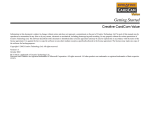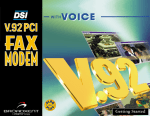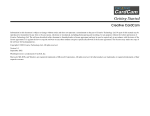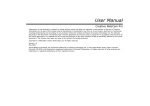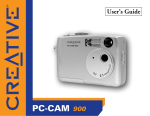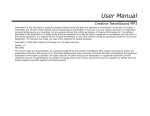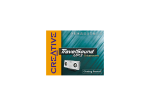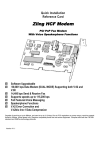Download Creative DI5611 User`s guide
Transcript
User’s Guide Creative Modem Blaster V.92 PCMCIA DI5611 Information in this document is subject to change without notice and does not represent a commitment on the part of Creative Technology Ltd. No part of this manual may be reproduced or transmitted in any form or by any means, electronic or mechanical, including photocopying and recording, for any purpose without the written permission of Creative Technology Ltd. The software described in this document is furnished under a license agreement and may be used or copied only in accordance with the terms of the license agreement. It is against the law to copy the software on any other medium except as specifically allowed in the license agreement. The licensee may make one copy of the software for backup purposes. Copyright © 2002-2003 Creative Technology Ltd. All rights reserved. Version 1.0 August 2003 Modem Blaster is a registered trademark of Creative Technology Ltd. in the United States and/or other countries. Microsoft, MS-DOS, and Windows are registered trademarks of Microsoft Corporation. All rights reserved. All other products are trademarks or registered trademarks of their respective owners. Contents Contents Before You Begin Package Contents ................................................................................................................................. v Recording Model and Serial Numbers........................................................................................... v Checking System Requirements....................................................................................................... v Technical Support and Warranty ................................................................................................... vi Product Registration........................................................................................................................... vi Document Conventions................................................................................................................... vii 1 Installing and Testing the Driver Installing the Driver In Windows XP/2000/Me/98 SE................................................................... Testing the Driver..................................................................................................................................... In Windows XP................................................................................................................................ In Windows 2000 ............................................................................................................................ In Windows 98 SE/Me.................................................................................................................... 1-1 1-2 1-2 1-3 1-4 2 Installing Hardware Installation Steps......................................................................................................................................... Step 1: Prepare your computer................................................................................................... Step 2: Connect to the telephone line...................................................................................... Notes on connecting the telephone line and telephone............................................................... 2-1 2-1 2-2 2-3 3 Uninstalling the Driver Uninstalling PC Card ................................................................................................................................ 3-1 In Windows 2000/XP..................................................................................................................... 3-1 ii In Windows 98 SE/Me.................................................................................................................... 3-2 4 Modem Features Plug and Play...................................................................................................................................... Faxes .................................................................................................................................................... Internet Access................................................................................................................................. Videoconferencing........................................................................................................................... V.92 features ............................................................................................................................................... V.44 Data Compression................................................................................................................ Quick Connect................................................................................................................................. PCM Upstream................................................................................................................................. Modem-On-Hold....................................................................................................................................... Using Incoming Modem-On-Hold.............................................................................................. Using Outgoing Modem-On-Hold ............................................................................................. 4-1 4-1 4-1 4-1 4-2 4-2 4-2 4-2 4-3 4-4 4-5 Appendixes A Technical Specifications Plug and Play ........................................................................................................................... Data Features......................................................................................................................... Fax Features............................................................................................................................ Videoconferencing Support............................................................................................... A-1 A-2 A-2 A-2 B Troubleshooting Difficulties Installing Software ................................................................................................................ B-1 Resolving Hardware Conflicts............................................................................................................... B-2 Resolving Conflicts in Windows XP/2000............................................................................... B-2 iii Resolving Conflicts in Windows Me/98 SE.............................................................................. Difficulties with Your PC Card ............................................................................................................. Difficulties with Modem-On-Hold ....................................................................................................... Difficulties In Windows XP .................................................................................................................... B-3 B-3 B-5 B-7 iv Before You Begin Before You Begin This section contains information you should know about before using this manual. Read the information carefully before proceeding further. Creative Modem Blaster® V.92 notebook PC Card Telephone adapter cord (RJ-11) Telephone cord coupler (RJ-11) Quick Start Leaflet Drivers, software and User’s Guide (on CD) America Online® CD Package Contents • • • • • • Recording Model and Serial Numbers Your PC Card has a model number and a serial number. After removing the PC Card from its packaging, write down its model and serial numbers for future reference. You will need to provide these numbers when contacting our Technical Support office. Checking System Requirements • • • • • Intel® Pentium® 133 MHz or higher IBM compatible notebook computer 32 MB RAM Available PC Card type-II compliant slot 20 MB of free hard disk space (100 MB recommended) Microsoft® Windows® 98 Second Edition (SE), Windows Millennium Edition (Me), Windows 2000 or Windows XP • CD-ROM drive installed • An audio card, a microphone and speakers are required for videoconferencing. Before You Begin v Technical Support and Warranty Technical Support information can be found in the Installation CD. Go to d:\support\<language>\support.pdf. Warranty information can be found in the Installation CD as well. Go to d:\warranty\<region>\<language>\warranty.pdf. Please keep your Proof of Purchase for the duration of the Warranty period. (replace d:\ with the drive letter of your CD-ROM drive, <region> with the region that you are in, and <language> with the language that the document is in) Product Registration Enjoy a host of benefits by registering your products during installation, or at www.creative.com/register. Benefits include: • Service and Product Support from Creative • Exclusive updates on promotions and events Before You Begin vi Document Conventions The following typographical conventions are used throughout this document. Note. This highlights additional or important information about a feature. Caution! This highlights proper usage of your product. Use this information to avoid risky situations. Warning! This warns you of possible hazards to yourself or your product, that may result in injury or damage. Before You Begin vii 1 Installing and Testing the Driver Installing and Testing the Driver Installing the Driver In Windows XP/ 2000/Me/98 SE After installing the modem driver, test the modem to ensure it has been installed properly. DO NOT insert the PC Card into your notebook computer before installing the software. 1. Insert the Installation CD into your CD-ROM drive. The disc supports Windows AutoPlay mode and starts running automatically. If not, enable your CD-ROM drive’s auto-insert notification feature. For more details, see “Difficulties Installing Software” on page B-1. 2. Select the applications and drivers to install, and then click the OK button. 3. Follow the onscreen instructions to complete the installation. 4. When prompted, restart your computer. To install the PC Card, refer to “Installation Steps” on page 2-1. Installing and Testing the Driver 1-1 Testing the Driver In Windows XP 1. Click Start -> Control Panel. 2. Double-click the Phone and Modem Options icon. 3. Click the Modems tab. 4. Click Creative Modem Blaster V.92 PCMCIA DI5611, and then click the Properties button. The Creative Modem Blaster V.92 PCMCIA DI5611 Properties dialog box appears. 5. Click the Diagnostics tab, and then click the Query Modem button to display the response status of your PC Card (Figure 1-1). If your PC Card is not responding, it may be due to a conflict between the PC Card and another peripheral device. To resolve the conflict, you must change the settings on your PC Card (see “Resolving Conflicts in Windows XP/2000” on page B-2). Figure 1-1 Installing and Testing the Driver 1-2 In Windows 2000 1. Click Start -> Settings -> Control Panel. 2. Double-click the Phone and Modem Options icon. 3. Click the Modems tab. 4. Click Creative Modem Blaster V.92 PCMCIA DI5611, and then click the Properties button. 5. Click the Diagnostics tab. The Creative Modem Blaster V.92 PCMCIA DI5611 Properties dialog box appears. 6. Click the Query Modem button to display the response status of your PC Card (Figure 1-2). If your PC Card is not responding, it may be due to a conflict between the PC Card and another peripheral device. To resolve the conflict, you must change the settings on your PC Card (see “Resolving Conflicts in Windows XP/2000” on page B-2). Figure 1-2 Installing and Testing the Driver 1-3 In Windows 98 SE/ Me 1. Click Start -> Settings -> Control Panel. 2. Double-click the Modems icon. The Modems Properties dialog box appears. 3. Click the Diagnostics tab (Figure 1-3). 4. Click the COM port that has been assigned to your modem. 5. Click the More Info button to display the response status of your PC Card. If your PC Card is not responding, it may be due to a conflict between the PC Card and another peripheral device. To resolve the conflict, you must change the settings on your PC Card (see “Resolving Conflicts in Windows Me/98 SE” on page B-3). Figure 1-3 Installing and Testing the Driver 1-4 2 Installing Hardware Installing Hardware Installation Steps DO NOT insert the PC Card into your notebook computer before installing the software. Step 1: Prepare your computer 1. Insert your PC Card into an available PC Card slot on your notebook (Figure 2-1). Figure 2-1 For Windows XP only 2. When the Found New Hardware Wizard dialog box appears, click the Next button. 3. When the Hardware Installation dialog box appears, click the Continue Anyway button. 4. Click the Finish button. Installing Hardware 2-1 Step 2: Connect to the telephone line 1. Locate the most convenient telephone wall outlet. If a telephone is already connected to it, unplug the telephone cable from the wall outlet. 2. Connect one end of the telephone adapter cord provided to the wall outlet and the other end to the PC Card 4-pin port of the PC Card (Figure 2-2). To telephone line wall outlet PC Card 4-pin port Telephone adapter cord (provided) Figure 2-2 Installing Hardware 2-2 3. If your notebook is too far away from the wall outlet, use the telephone cord coupler to extend the telephone adapter cord. See Figure 2-3 below. To telephone line wall outlet PC Card 4-pin port Telephone cord coupler (provided) Telephone adapter cord (provided) Figure 2-3 Notes on connecting the telephone line and telephone Before using the PC Card, you need to connect your telephone line and telephone to the PC Card. To ensure that your PC Card works properly, know that: • Your PC Card cannot be used on “party lines”, nor can it be used on toll or coin-operated lines. Contact your local telephone company for help if you are not sure about the suitability of your telephone line. • This PC Card is intended for use on an analog telephone line, also called a POTS (Plain Old Telephone Service) line. This PC Card cannot be connected directly to a digital telephone line, such as those commonly found in businesses. Either obtain an analog line or an analog converter compatible with the telephone line you are using. Installing Hardware 2-3 3 Uninstalling the Driver Uninstalling the Driver Uninstalling PC Card You may at times need to uninstall and then reinstall the PC Card to correct problems, change configurations, or make version upgrades. The following instructions tell you how to uninstall the PC Card. In Windows 2000/ XP 1. Click Start -> Settings -> Control Panel. For Windows XP, click Start -> Control Panel. 2. Double-click the Add or Remove Programs icon. 3. Click the Change or Remove Programs button (Figure 3-1). 4. Click Creative Modem Blaster V.92 PCMCIA DI5611, and then click the Change/Remove button. 5. Turn off your computer and remove the PC Card. Figure 3-1 Uninstalling the Driver 3-1 In Windows 98 SE/ Me 1. Click Start -> Settings -> Control Panel. 2. Double-click the Add/Remove Programs icon. The Add/Remove Programs Properties dialog box appears. 3. Click the Install/Uninstall tab (Figure 3-2). 4. Click Creative Modem Blaster V.92 PCMCIA DI5611, and then click the Add/Remove button. 5. Turn off your computer and remove the PC Card. Figure 3-2 Uninstalling the Driver 3-2 4 Modem Features Modem Features Besides transferring data and accessing online information, your Creative Modem Blaster has the following features: Plug and Play This feature allows you to install your PC Card easily, as it is automatically configured. Faxes Use your PC Card to send and receive fax documents. This feature also allows you to configure the modem to serve as a fax-on-demand system by using the software provided. Internet Access Internet Support with the latest drivers and V.92 protocols available for download to ensure fast connections and the best online experience every time you connect. Videoconferencing Your PC Card comes complete with V.80 standard support, for use with H.32x videoconferencing systems. Modem Features 4-1 V.92 features Your Internet Service Provider (ISP) must be able to support the following V.92 features before you can use them. V.44 Data Compression V.44 Data Compression reduces the time it takes to load web pages, run web searches, and receive e-mail with new compression designed specifically for the Internet. Quick Connect Quick Connect cuts dial-up time to as little as half, by learning how to connect to your ISP the first time you call and repeating that for future connections. PCM Upstream PCM Upstream increases your upload speed by as much as 40 percent, so you can send e-mails with attachments, send files through Instant Messaging programs, and upload pictures to a website much faster. Modem Features 4-2 Modem-OnHold Your Modem Blaster offers complete Modem-On-Hold support so you can pause your Internet connection while you answer incoming phone calls and while you make outgoing phone calls. Since Modem-On-Hold also requires support from your ISP, you may need to check with them to ensure that this feature is supported in your area. Incoming Modem-On-Hold Incoming Modem-On-Hold works with Call Waiting service from your phone company to pause your Internet connection while you answer calls. With the Caller ID service, Incoming Modem-On-Hold also identifies incoming callers. Outgoing Modem-On-Hold Outgoing Modem-On-Hold works with the Three-Way Calling service from your Phone company to let you pause your Internet connection while you make phone calls. If Modem-On-Hold has been enabled, but your ISP does not support this feature, click the Accept or Reject button as appropriate. The Internet connection is automatically cut off if you choose to accept a call. Modem Features 4-3 Using Incoming 1. Modem-On-Hold If a call comes in while you are on the Internet, a dialog box similar to Figure 4-1 appears, asking you if you want to answer the call, click the Accept button . • Your phone line needs to be Call Waiting enabled to support Modem-OnHold. • Your Internet Service Provider (ISP) must be able to support ModemOn-Hold features. • The amount of hold time in Figure 4-2 depends on your ISP. A dialog box similar to Figure 4-2 appears, telling you the length of time you have to complete the call (hold time). The call is cut off automatically after that. Figure 4-1 Figure 4-2 2. After completing your call, click the Reconnect button . The length of hold time available is determined by your ISP. If your call is longer than the available hold time, your Internet connection will be disconnected and you will need to dial-up again after completing the call. Modem Features 4-4 Using Outgoing Modem-On-Hold • Modem-On-Hold requires Three-Way Calling to make phone calls. 1. Click the NetWaiting icon on the taskbar. A dialog box similar to Figure 4-3 appears. 2. Click the Outgoing call button . You can start making your phone call. A dialog box similar to Figure 4-4 appears, telling you the length of time you have to complete your call. The call is automatically cut off after that. • NetWaiting needs to be installed and activated in your computer before Modem-On-Hold can work. Figure 4-3 • The waiting time depends on your ISP. Figure 4-4 3. After completing your call, click the Reconnect button reconnect to the Internet. . The PC Card will Modem Features 4-5 A Technical Specifications Technical Specifications This appendix lists the general specifications of your modem. Plug and Play ❑ Plug and Play resources. Figure A-1: Plug and Play Resource Information. DEPENDENT FUNCTIONS RESOURCE INFORMATION Choice 1 COM 3 I/O Port: 3E8 to 3EF IRQ: 3, 4, 5, 7, 9, 10, or 11 Choice 2 COM 4 I/O Port: 2E8 to 2EF IRQ: 3, 4, 5, 7, 9, 10, or 11 Choice 3 COM 2 I/O Port: 2F8 to 2FF IRQ: 3 Choice 4 COM 1 I/O Port: 3F8 to 3FF IRQ: 4 Choice 5 Free-For-All I/O Port: 2A0 to 2A7, 2A8 to 2AF, ... 2D8 to 2DF IRQ: 3, 4, 5, 7, 9, 10, 11 or 15 Technical Specifications A-1 Data Features ❑ Integrated data, fax, and voice mail modem. ❑ 56,000/54,667/53,333/52,000/50,667/49,333/48,000/46,667/45,333/42,667/41,333/ 40,000/38,667/37,333/36,000/34,667/33,333/32,000 Due to line conditions and FCC regulations, your data rate may be lower. Current FCC regulations limit download speeds to 53 kbps maximum. Fax Features ❑ 33,600/31,200/28,800/26,400/24,000/21,600/19,200/16,800/14,400/ 12,000/9,600/ 7,200/4,800/2,400/1,200/300 bps data speeds. ❑ Compatibility with the following data modem standards: • V.92, V.90, V.34, V.32bis, V.32, V.23, V.22bis, V.22, and V.21; Bell 212A and 103. • V.42 LAPM and MNP2-4 error correction. • V.44, V.42bis and MNP5 data compression. ❑ Automatic dial and answer capabilities. ❑ Supports Class 1 fax commands. ❑ Fax speeds up to 14,400 bps for send and receive. ❑ Compatibility with the following fax modem transmission standards: • V.17 (14400 bps) • V.27ter (7200 bps) • V.29 (9600 bps) Videoconferencing Support ❑ Supports ITU V.80 standard to allow high performance video conferencing over standard phone lines and the internet. Videoconferencing standards are H.324 and H.323. Technical Specifications A-2 B Troubleshooting Troubleshooting This appendix provides tips and solutions for resolving some of the difficulties you might encounter with Creative Modem Blaster V.92 PCMCIA DI5611, either during installation or normal use. Difficulties Installing Software The installation does not start automatically after the Creative Modem Blaster Installation CD is inserted. The AutoPlay feature in Windows may not be enabled. To start the installation program through the My Computer shortcut menu: 1. Double-click the My Computer icon on your Windows desktop. 2. In the My Computer window, right-click the CD-ROM drive icon. 3. On the shortcut menu, click AutoPlay and follow the instructions on the screen. To install the software from the CD without enabling AutoPlay: 1. Leave the installation CD in the CD-ROM drive. 2. Click Start -> Run. 3. In the Run dialog box, type d:\ctrun\ctrun.exe (replace d:\ with the drive letter of your CD-ROM drive). 4. Follow the instructions on the screen to complete the installation. To enable AutoPlay through Auto Insert Notification: 1. Click Start -> Settings -> Control Panel. 2. Double-click the System icon. 3. In the System Properties dialog box, click the Device Manager tab and select your CD-ROM drive. 4. Click the Properties button. Troubleshooting B-1 5. In the Properties dialog box, click the Settings tab and select Auto Insert Notification. 6. Click the OK button to exit from the dialog box. Resolving Hardware Conflicts Hardware conflicts may occur when two or more peripheral devices are set to use the same I/O address, IRQ line or DMA channel. Resolving Conflicts in Windows XP/ 2000 To run Device Manager: To resolve conflicts in Windows XP, Windows 2000, Windows Me or Windows 98 SE, change the resource settings of your PC Card or the conflicting peripheral device using Device Manager. 1. Click Start -> Settings -> Control Panel. 2. Click the System icon. The System Properties dialog box appears. 3. Click the Hardware tab. 4. Click the Device Manager button. 5. Double-click Modem. 6. Right-click the name of your PC Card. A menu appears. 7. Select the Properties option. 8. Click the Resources tab. 9. Click the Use Automatic Settings check box to select it. If this check box is already selected, you need to go to the Properties dialog box of the conflicting peripheral device and select the same check box there. Restart your system to allow Windows XP/2000 to reassign resources to your PC Card and/or the conflicting peripheral device. Troubleshooting B-2 Resolving Conflicts in Windows Me/98 SE If you are unsure of which peripheral device is causing the conflict, you can isolate the source of the difficulty by temporarily removing all devices (except your PC Card and essential devices such as the disk controller). After that, add the devices back one at a time until the device that is causing the conflict is found. Difficulties with Your PC Card To run Device Manager: 1. Click Start -> Settings -> Control Panel. 2. Click the System icon. The System Properties dialog box appears. 3. Click the Device Manager tab. 4. Double-click Modem. 5. Select your PC Card and click the Properties button. The Properties dialog box of the PC Card appears. 6. Click the Resources tab. 7. Click the Use Automatic Settings check box to select it. If this check box is already selected, you need to go to the Properties dialog box of the conflicting peripheral device and select the same check box there. 8. Restart your system to allow Windows Me/98 SE to reassign resources to your PC Card and/or the conflicting peripheral device. The PC Card fails to accept commands to dial or answer a call. There may be an improper telephone line connection. Check the following: • Make sure the telephone adapter cord is attached to the RJ-11 port. • Check that all devices are turned on. There is interference on the telephone line that is connected to the PC Card. To resolve this difficulty: Troubleshooting B-3 Try moving the telephone line away from any power source, monitor, printer or any computer cable. The PC Card cannot connect to the Internet at 56,000 bps. This may be due to line conditions in your area. Due to FCC regulations and/or line conditions, it is not always possible to achieve the maximum data rate. To resolve this difficulty: Try moving the telephone line away from any power source, monitor, printer or computer cable. The PC Card or communications software fails to detect that the remote user has hung up. The PC Card or communications software relies on the dial tone, busy tone or silence period to detect that a remote user has hung up. This detection may fail due to one of the following reasons: • Your local telephone system does not generate the dial or busy tone when the remote user hangs up. • The silent period for the PC Card or communications software to detect that the remote user has hung up is not long enough. • The PC Card or communications software cannot detect a different dial or busy tone. For example, if you are connecting to a PABX system, the dial or busy tone generated is different from the usual dial or busy tone. To resolve this difficulty: Prompt the remote user to respond. This may, however, result in a long delay before the communications software responds to the remote user hanging up. To minimize this delay, modify the following settings: • Voice message recording time. • Number of prompts. • Time to wait for a response after prompting. Troubleshooting B-4 No dial tone when using the PC Card. The IRQ of the PC Card is either in conflict with another device or is mis-reported in Windows. To resolve this difficulty: Many chipsets have IRQ routing drivers for Windows. If you have an internal PC Card, and these drivers do not work or do not exist on your system, insert the PC Card into a different PC Card slot. Difficulties with ModemOn-Hold Internet connection is lost after incoming or outgoing phone calls. This may be caused by the following reason: Outgoing phone calls are affected because your phone service does not include the 3-Way Calling feature. To reresolve this difficulty: Contact your telephone service provider to enable the 3-Way calling feature. This may also be caused by the following reason: Your Internet Service Provider (ISP) does not support Modem-On-Hold. To reresolve this difficulty: Contact your ISP to determine whether they support Modem-On-Hold. If your ISP does not support Modem-On-Hold, you may wish to disable call-waiting when going online. Your PC Card can be set to automatically disable Call Waiting while online by following the steps below. To disable Call Waiting in Windows 98 SE/Me: 1. For Windows 98 SE users, double-click the My Computer icon located on your Windows Desktop, and then click the Dial-up Networking icon. For Windows Me users, click Start -> Settings -> Control Panel, and then click the Dial-Up Networking icon. 2. Double-click the icon for your internet connection. The Connect To dialog box appears. Troubleshooting B-5 3. Click the Dial Properties button, and then click the check box next to the To disable call waiting, dial option. 4. Click the arrow next to the To disable call waiting, dial box. Three options are displayed: *70, 70# and 1170. 5. Select the appropriate option. If you are unsure which option is appropriate for your area, contact your ISP for more information. 6. Click the Apply button, and then click the OK button. To disable Call Waiting in Windows 2000/XP (in Classic View): 1. Click Start -> Settings -> Control Panel. 2. Double click the Phone and Modem Options icon. The Edit Location dialog box appears. 3. Click your internet location from the list to select it, and then click the Edit button. 4. Click the check box next to the To disable call waiting, dial option. 5. Click the arrow next to the To disable call waiting, dial box. Three options are displayed: *70, 70# and 1170. 6. Select the appropriate option. If you are unsure which option is appropriate for your area, contact your ISP for more information. Troubleshooting B-6 Difficulties In Windows XP A Hardware Installation error message appears on a Windows XP operating system when a driver is being installed. At the time of this product's release, Microsoft strongly encouraged companies to submit their hardware solutions for certification. If a hardware device driver is not submitted, or does not qualify, for Microsoft certification, a warning message similar to the one below appears. You may see this message when installing this driver or update. If you do, you may choose to click the Continue Anyway button. Creative has tested this driver on Windows XP, and it does not impair or destablize your computer. Troubleshooting B-7









































